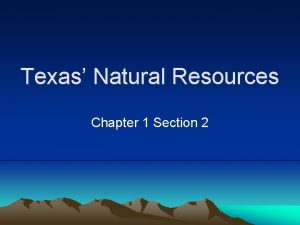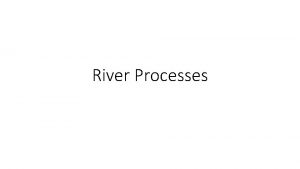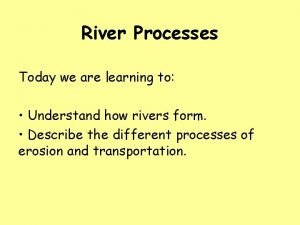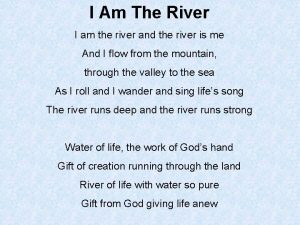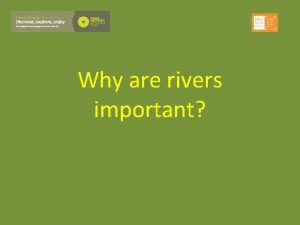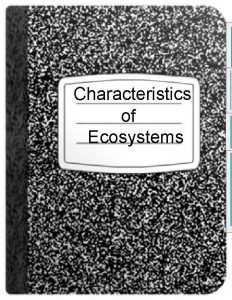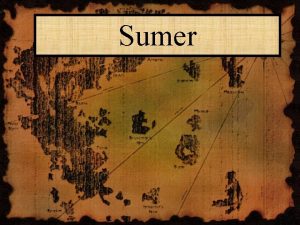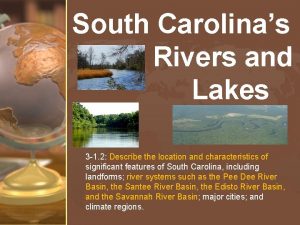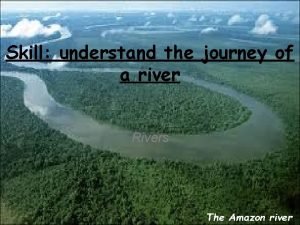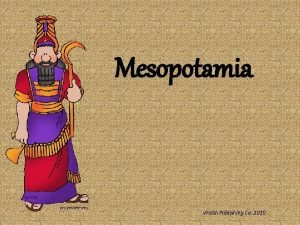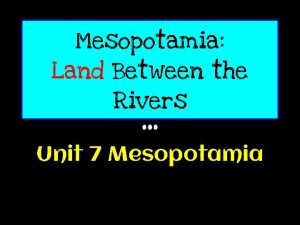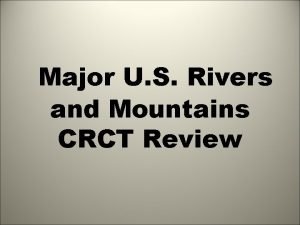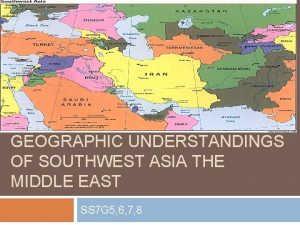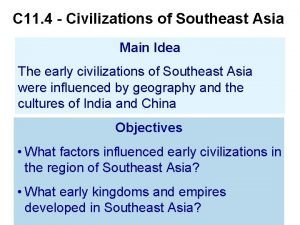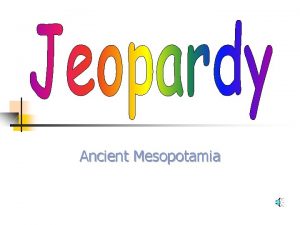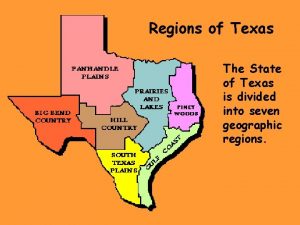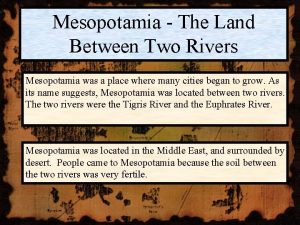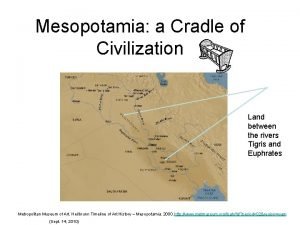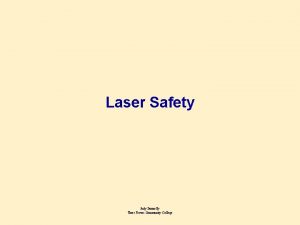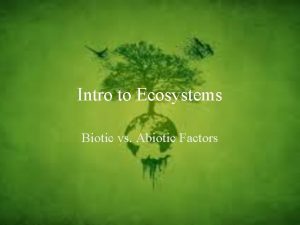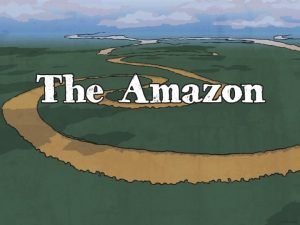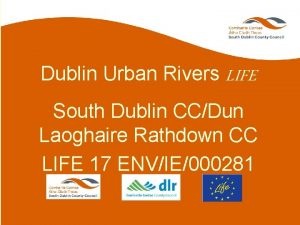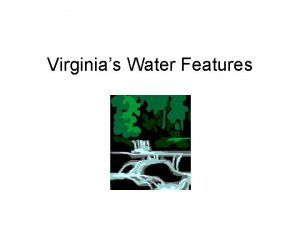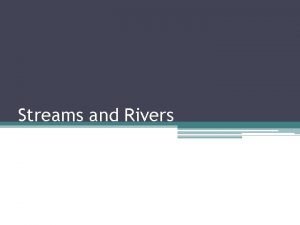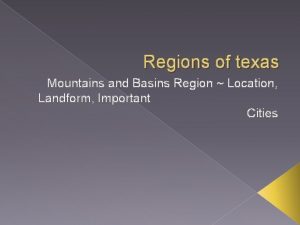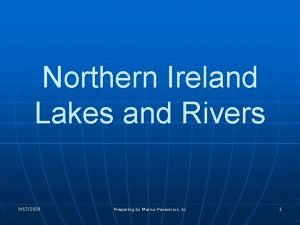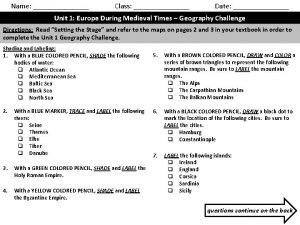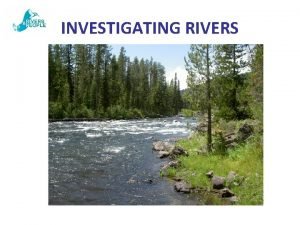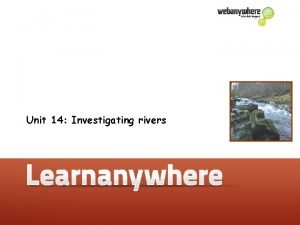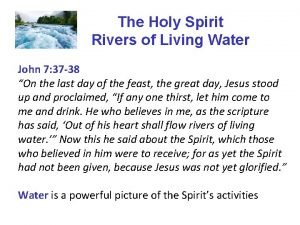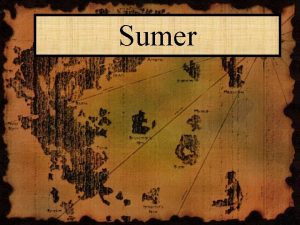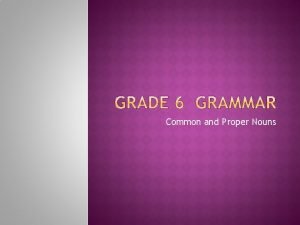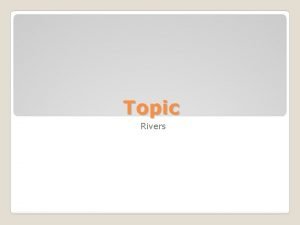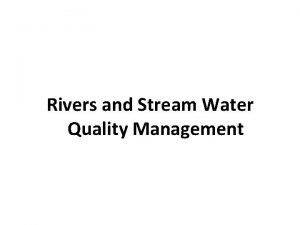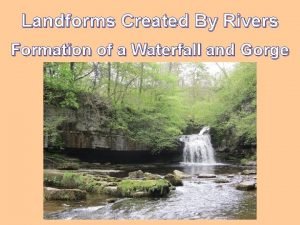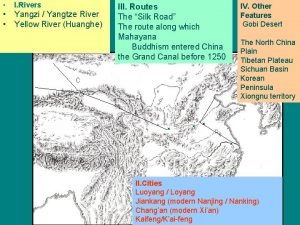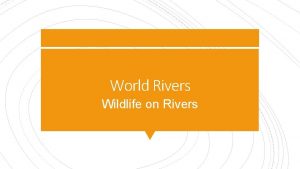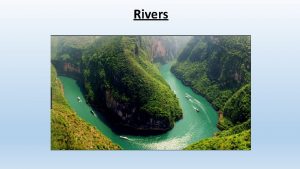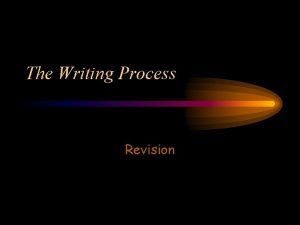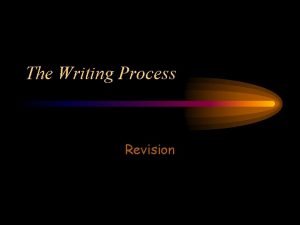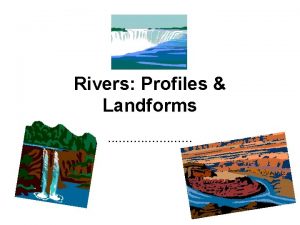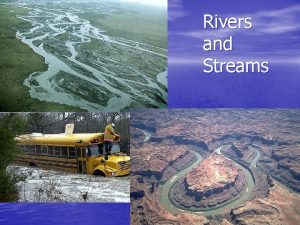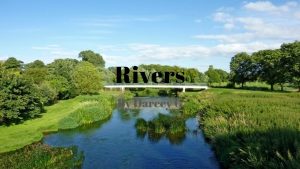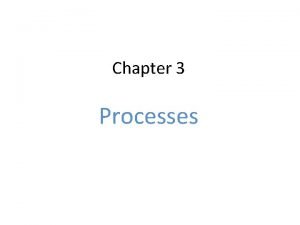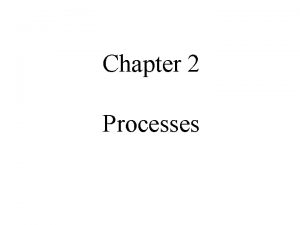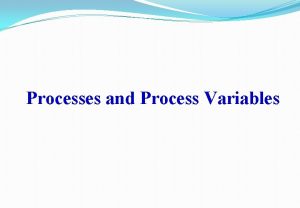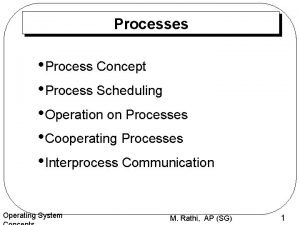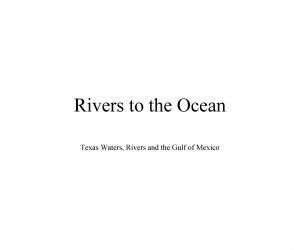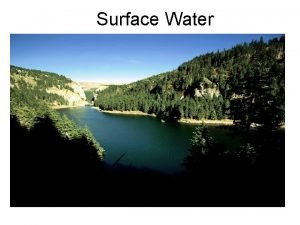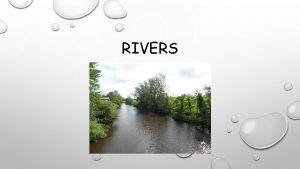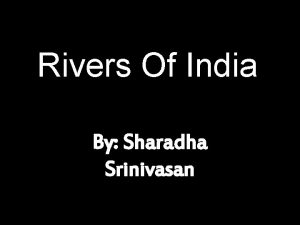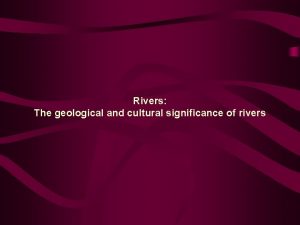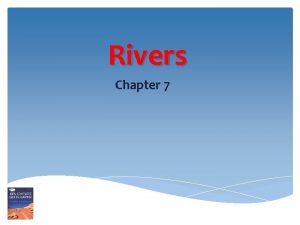Rivers revision River Processes A river process is























![Explain the processes involved in the formation of waterfalls. [7 marks] Describe the geology Explain the processes involved in the formation of waterfalls. [7 marks] Describe the geology](https://slidetodoc.com/presentation_image_h2/7af7e1a3499e08a80638dcd5d2bd8b0a/image-24.jpg)














![Explain the processes involved in the formation of an ox-bow lake [7 marks] Explain Explain the processes involved in the formation of an ox-bow lake [7 marks] Explain](https://slidetodoc.com/presentation_image_h2/7af7e1a3499e08a80638dcd5d2bd8b0a/image-39.jpg)


















- Slides: 57

Rivers revision


River Processes A river process is something that happens in the river. The main processes in the river are Erosion - where parts of the river bed and bank get eroded / removed from the landscape Transportation - where the eroded material is carried from one place to another through the river system Deposition - where the river load becomes too heavy for the river to carry and is dumped down / deposited.

On your whiteboards…. Write down the 4 processes of erosion

A river can erode material from its bed and banks in 4 main ways • Attrition: large particles such as boulders collide and break into smaller pieces (occurs at higher part of river) • Hydraulic action: the sheer force of the river dislodges particles from its banks and bed • Abrasion: smaller particles rub against the river banks and bed like sand-paper; occurs at low part of river (smaller particles) • Solution: acids in river dissolve rocks (occurs at any part of river)

Methods of Erosion • Abrasion – • Hydraulic Action • Attrition • Solution-

On your whiteboards…. Write down the 4 processes of transportation

• Traction: rolling stones along the bed • Saltation: small particles bounce along bed in a leapfrog motion • Suspension: silt and clay-sized are carried within the water flow • Solution: minerals dissolve in the water

solution

River Features • Rivers are eroding, transporting and depositing constantly within the drainage basin system. • The river can be divided into 3 sections – Upper Course at the Source, Middle Course and Lower Course at the Mouth of the river. The river displays different characterisitics at each section

The V - Shaped Valley

Can you mark the V-shaped valley’s on these photos?



Use this sketch to help explain how they form Vertical abrasion

Also known as ‘Torrent’ or ‘Youth’ stages Interlocking Spurs In the Upper Course, the river is fast flowing, but there is little water and load. The river is often called a stream and does not have the erosive power to remove the hillsides (spurs), but erodes downwards instead. EROSION TYPE: Vertical and Headward


Waterfalls and Gorges 20 million visit the falls every year Visitors !!!

1. Draw the stages in the formation of a waterfall 2. Explain in as much detail what is happening at 3 3. What is happening here? (see next slide)



Waterfall and Gorge 1 (OBLIQUE AERIAL VIEW) EROSION TYPE: Vertical and Headward

Waterfall and Gorge 2 (PROFILE VIEW) EROSION TYPE: Vertical and Headward
![Explain the processes involved in the formation of waterfalls 7 marks Describe the geology Explain the processes involved in the formation of waterfalls. [7 marks] Describe the geology](https://slidetodoc.com/presentation_image_h2/7af7e1a3499e08a80638dcd5d2bd8b0a/image-24.jpg)
Explain the processes involved in the formation of waterfalls. [7 marks] Describe the geology of where a waterfall forms Explain how the overhang and plunge pool are then created. Use key terms and refer to difference erosion processes.

Meanders 2. What type of erosion do you think is happening? 1. Can you mark the fastest flow on this?


What is a meander? . . can you mark on this the fastest flow?

What is a meander … where do you think erosion would take place?

What is a meander? Can you draw a cross section x-y?

What is a meander? … this is what a cross section through a meander looks like

Also known as the ‘Mature’ stage Meanders 1 (Aerial View) Meanders are formed because the current swings to the outside of a bend and concentrates the erosion there. Deposition occurs on the inside of the bed where there is not enough energy to carry load. EROSION TYPE: Lateral

Meanders 2 (Profile View / Cross Section X - Y) EROSION TYPE: Lateral This cross section clearly shows the eddy current (near ’X’) formed by the velocity of the river being concentrated on the outside of the bend. These UNDERCUT the bank causing the formation of a RIVER CLIFF. On the inside (NEAR ‘Y’), a SLIP-OFF-SLOPE is formed where current is too slow to carry any load.

What is a meander? … this is what a cross section through a meander looks like


What is Meander Migration …. What do you think might happen here?

What is Meander Migration

Ox-Bow Lake 1 (Aerial View) Ox-bow lakes are formed when two meander RIVER CLIFFS are being eroded towards each other. These will eventually meet, causing the river to then flow across the bottom of the diagram. EROSION TYPE: Lateral

Ox-Bow Lake 2 (Aerial View)
![Explain the processes involved in the formation of an oxbow lake 7 marks Explain Explain the processes involved in the formation of an ox-bow lake [7 marks] Explain](https://slidetodoc.com/presentation_image_h2/7af7e1a3499e08a80638dcd5d2bd8b0a/image-39.jpg)
Explain the processes involved in the formation of an ox-bow lake [7 marks] Explain the formation of a meander Explain the role of erosion in the formation of an oxbow lake Explain the role of deposition in the formation of an ox-bow lake

What are Flood Plains and levees? • Floodplain Levees

Leeves River

Leveés and Raised Beds 1 (Front View) DEPOSITION FEATURE: no erosion in the Lower Course Leveés are formed when rivers flood. The river water overflows the banks of the river and immediately slows down due to friction with the FLOODPLAIN. This drops the larger particles first, building up a raised river bank called a LEVEÉ.

Leveés and Raised Beds 2 (Front View) DEPOSITION FEATURE: no erosion in the Lower Course Raised beds form in the Summer months when the river volume and energy are low and load is dropped onto the river bed. The bed raises up and the capacity of the river reduces, causing flooding in the winter. This in turn builds up the leveés and the whole process raises up the level of the river in the landscape.

Delta (Aerial View) This deposition feature is one of the largest. When the flowing river hits the non-flowing sea, energy is suddenly lost. This causes all of the load in the river to drop in the river MOUTH. This builds up over time to create a delta – an area of land. The river divides into DISTRIBUTARIES to continue to the sea, which is now some way away from its original meeting point.


Can you work out what the river is trying to do by using this diagram?




Bangladesh floods

Case Study - Bangladesh Human causes of the floods Physical causes of floods Immediate effects Post it note it…. Later effects Flood management

Explain how physical and human factors can increase the risk of river flooding (7 marks) Identify one physical factor, explain how it increases the risk of river flooding Identify one human factor, explain how it increases the risk of flooding. Identify one physical or human factor, explain how it increases the risk of flooding.


Exam question Describe the benefits and costs of living near a river (7) Step 2: On one hand. . . Step 3: On the other hand. . . Benefits of living near a river Problems of living near a river t in Po Li nk Literacy Can you use these key terms: • Whereas • However • On the other hand Li nk eans This m Because ple Exam This m eans Because Can you explain what conclusion you would reach? t Exam ple Challenge in Po ox the B command word (s) U nderline the key words M arks- How many?

Benefits of living near a river Issues of living near a river

Describe the benefits and costs of living near a river (7) Identify a benefit of living near a river. Why is this beneficial in this area? Include specific case study detail Identify a problem of living near a river. Why is this a problem in this area? Include specific case study detail Conclusion

What do these two images show? How do they help prevent floods? What are the benefits and issues with each?
 Why are some rivers in texas called “wrong way” rivers?
Why are some rivers in texas called “wrong way” rivers? Passive voice revision
Passive voice revision Concurrent in os
Concurrent in os 4 types of erosion
4 types of erosion What are the processes involving river transportation
What are the processes involving river transportation What processes are crucial to the ipde process
What processes are crucial to the ipde process Tukwila
Tukwila I am the river and the river is me
I am the river and the river is me Why are rivers important
Why are rivers important Characteristics of wetlands
Characteristics of wetlands Symbol of a river
Symbol of a river 2 rivers in mesopotamia
2 rivers in mesopotamia South carolina rivers and lakes
South carolina rivers and lakes Journey of a river
Journey of a river By the rivers of babylon psalm
By the rivers of babylon psalm Only when all the rivers have run dry
Only when all the rivers have run dry Sumerian house
Sumerian house Mesopotamia contribution
Mesopotamia contribution Two rivers in mesopotamia
Two rivers in mesopotamia Which of the following is the best title for this list?
Which of the following is the best title for this list? What rivers run through iraq
What rivers run through iraq Trung trac
Trung trac What 2 rivers surround mesopotamia
What 2 rivers surround mesopotamia Regions of texas
Regions of texas 2 rivers of mesopotamia
2 rivers of mesopotamia Scribes
Scribes Cradles of civilization map
Cradles of civilization map 3 rivers optical
3 rivers optical Biotic tree
Biotic tree Rivers passing through sherwood forest
Rivers passing through sherwood forest Label the niger and senegal rivers
Label the niger and senegal rivers Dublin urban rivers life project
Dublin urban rivers life project Important water features of virginia
Important water features of virginia Types of bodys of water
Types of bodys of water Plants in the mountains and basins region of texas
Plants in the mountains and basins region of texas What is the longest river in northern ireland
What is the longest river in northern ireland Label the seine thames elbe tiber and danube rivers
Label the seine thames elbe tiber and danube rivers Jane eyre chapter 31
Jane eyre chapter 31 How delta is formed
How delta is formed Investigating rivers
Investigating rivers Holy spirit living water
Holy spirit living water Symbol of rivers
Symbol of rivers What is the land between two rivers called
What is the land between two rivers called Mesopotamia land between two rivers
Mesopotamia land between two rivers Count nouns and proper nouns
Count nouns and proper nouns Longest rivers in asia
Longest rivers in asia What has roads but no cars rivers but no water
What has roads but no cars rivers but no water Longest rivers in china
Longest rivers in china 3 rivers indian clinic muskogee
3 rivers indian clinic muskogee Topic river
Topic river Paris basin sketch map
Paris basin sketch map How did its rivers affect eastern europe
How did its rivers affect eastern europe Gcwak
Gcwak Rivers
Rivers Psalm 137
Psalm 137 How does a waterfall form
How does a waterfall form Huang he and yangtze rivers
Huang he and yangtze rivers Interlocking spurs definition geography
Interlocking spurs definition geography
